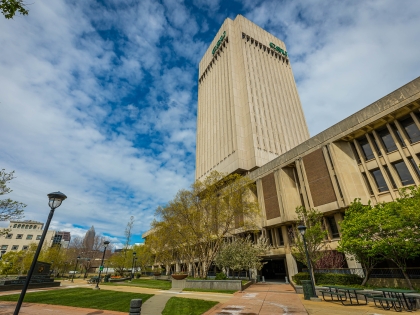‘Textbook Equity’ Initiative Cracks $1M in Savings for CSU Students

Michael Schwartz Library, faculty engage open educational resources, affordability grants to level learning experiences for all
In conjunction with the Center for Faculty Excellence and the Center for eLearning, Cleveland State University’s Michael Schwartz Library has been offering Textbook Affordability Small Grants to faculty since 2016. Aiming for increased adoption of openly licensed course materials, the library has awarded 45 grants to date, saving students over $1 million in course material costs.
The high cost of textbooks has been shown to have adverse impacts on students’ academic experience—from which classes they choose, to their ability to succeed in those classes. Textbook Affordability Grants provide project- and financial support for faculty undertaking this work.
“We have many faculty members we call ‘affordability advocates,’” said Mandi Goodsett, performing arts & humanities librarian, copyright and open educations resources (OER) advisor at the library.
Goodsett indicated that the dataset arriving at the $1 million number was triangulated by the CSU Office of Institutional Research, whereby enrollment numbers were measured against instructors receiving grants for their classes.
That data was then married then to the universally accepted national institutional figure of $100 savings per student, “unless our data determined that the savings for students were lower,” she said.
Free course materials remove the barrier to access and allow faculty to tailor materials specifically for their classes with open license information.
What’s more, library staff has committed to assisting faculty in the adoption, creation, customization, and collation of open materials that are of high educational quality and exceptional value.
The move has led an increase in student usage of materials according to professors, as well as an increase in overall fact absorption and student performance. If students aren’t bringing the significantly lighter printed packet to class, then they’re pulling up the information on a phone, laptop or tablet, said Goodsett.
Instructors, in turn, are bringing up content on screens and boards in their respective classrooms and integrating materials into the lessons in real time—saving valuable lecture and lesson prep time.
CSU has been a leader in textbook affordability efforts in Ohio since 2014, when it became a founding member Open Textbook Network, which now has over 1000 campus members around the world.
Former library director Glenda Thornton, was instrumental in initiating OhioLINK’s current Ohio Affordable Learning initiative, which has been actively supporting a $1.5 million Ohio Department of Higher Education grant awarded to a collection of universities and colleges across Ohio.
Several CSU faculty members have also been team members for these grant projects.
“Students will go without textbooks for a variety of reasons—budgetary restrictions, financial hardships. Having librarians help find and evaluate materials for faculty absolutely levels the playing field for students,” Goodsett offered.
She said that the library respects the academic freedom of some instructors to choose commercial textbooks over open sourced materials and “we certainly don’t force anyone to adopt them,” but that on balance, the initiative’s sixth year continues to have a positive response.
“When professors make efforts to reduce the cost of textbooks, it makes me feel like they care about my success as a student,” said Sam Paskert, Spring 2020 College of Liberal Arts and Social Sciences Valedictorian. “They seem to be very understanding of what it’s like to be broke.”
“At the end of the day, it’s an equity issue for our students—allowing everyone equal access to instructional materials—and this has been a great return on investment,” Goodsett said.
Learn more about CSU’s Textbook Affordability Small Grants online.